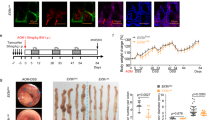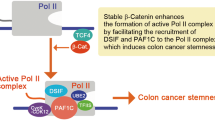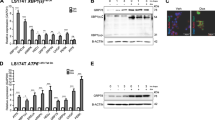Abstract
Translational control of gene expression has recently been recognized as an important mechanism controlling cell proliferation and oncogenesis, and it mainly occurs in the initiation step of protein synthesis that involves multiple eukaryotic initiation factors (eIFs). Many eIFs have been found to have aberrant expression in human tumors and the aberrant expression may contribute to oncogenesis. However, how these previously considered house-keeping proteins are potentially oncogenic remains elusive. In this study, we investigated the expression of eIF3i in human colon cancers, tested its contribution to colon oncogenesis and determined the mechanism of eIF3i action in colon oncogenesis. We found that eIF3i expression was upregulated in both human colon adenocarcinoma and adenoma polyps as well as in model inducible colon tumorigenic cell lines. Overexpression of ectopic eIF3i in intestinal epithelial cells causes oncogenesis by directly upregulating the synthesis of cyclooxygenase-2 (COX-2) protein and activates the β-catenin/T-cell factor 4 signaling pathway that mediates the oncogenic function of eIF3i. Together, we conclude that eIF3i is a proto-oncogene that drives colon oncogenesis by translationally upregulating COX-2 and activating the β-catenin signaling pathway. These findings imply that proto-oncogenic eIFs likely exert their tumorigenic function by regulating/altering the synthesis level of downstream tumor suppressor or oncogenes.
This is a preview of subscription content, access via your institution
Access options
Subscribe to this journal
Receive 50 print issues and online access
$259.00 per year
only $5.18 per issue
Buy this article
- Purchase on Springer Link
- Instant access to full article PDF
Prices may be subject to local taxes which are calculated during checkout








Similar content being viewed by others
References
Mathews MB, Sonenberg N, Hershey JW . Translational Control in Biology and Medicine. Cold Spring Harbor Laboratory Press, Cold Spring Harbor, NY, USA, 2007.
Schneider RJ, Sonenberg N . Translational control in cancer development and progression. In: Mathews MB, Sonenberg N, Hershey JW (eds) Translational Control in Biology and Medicine. Cold Spring Harbor Laboratory Press, Cold Spring Harbor, NY, USA, 2007, pp 401–431.
Dong Z, Zhang JT . Initiation factor eIF3 and regulation of mRNA translation, cell growth, and cancer. Crit Rev Oncol Hematol 2006; 59: 169–180.
Masutani M, Sonenberg N, Yokoyama S, Imataka H . Reconstitution reveals the functional core of mammalian eIF3. EMBO J 2007; 26: 3373–3383.
Yin JY, Dong Z, Liu ZQ, Zhang JT . Translational control gone awry: a new mechanism of tumorigenesis and novel targets of cancer treatments. Biosci Rep 2011; 31: 1–15.
Zhou M, Sandercock AM, Fraser CS, Ridlova G, Stephens E, Schenauer MR et al. Mass spectrometry reveals modularity and a complete subunit interaction map of the eukaryotic translation factor eIF3. Proc Natl Acad Sci USA 2008; 105: 18139–18144.
Markowitz AJ, Wu GD, Bader A, Cui Z, Chen L, Traber PG . Regulation of lineage-specific transcription of the sucrase-isomaltase gene in transgenic mice and cell lines. Am J Physiol 1995; 269: G925–G939.
Pinto M, Robine-Leon S, Appay MD, Kedinger M, Triadou N, Dussaulx E et al. Enterocyte-like differentiation and polarization of the human colon carcinoma cell line Caco-2 in culture. Biol Cell 1983; 47: 323–330.
Zweibaum A, Chantret I . Human colon carcinoma cell lines as in vitro models for the study of intestinal cell differentiation. In: Smith MW, Sepulveda FV (eds) Adaptation and Development of Gastrointestinal Function. Manchester University Press, Manchester, UK, 1989, pp 103–112.
Ding QM, Ko TC, Evers BM . Caco-2 intestinal cell differentiation is associated with G1 arrest and suppression of CDK2 and CDK4. Am J Physiol 1998; 275: C1193–C1200.
Markowitz SD, Bertagnolli MM . Molecular origins of cancer: molecular basis of colorectal cancer. N Engl J Med 2009; 361: 2449–2460.
Castellone MD, Teramoto H, Williams BO, Druey KM, Gutkind JS . Prostaglandin E2 promotes colon cancer cell growth through a Gs-axin-beta-catenin signaling axis. Science 2005; 310: 1504–1510.
Rauch J, Ahlemann M, Schaffrik M, Mack B, Ertongur S, Andratschke M et al. Allogenic antibody-mediated identification of head and neck cancer antigens. Biochem Biophys Res Commun 2004; 323: 156–162.
Matsuda S, Katsumata R, Okuda T, Yamamoto T, Miyazaki K, Senga T et al. Molecular cloning and characterization of human MAWD, a novel protein containing WD-40 repeats frequently overexpressed in breast cancer. Cancer Res 2000; 60: 13–17.
Gray SG, Kytola S, Lui WO, Larsson C, Ekstrom TJ . Modulating IGFBP-3 expression by trichostatin A: potential therapeutic role in the treatment of hepatocellular carcinoma. Int J Mol Med 2000; 5: 33–41.
Bernardini S, Melino G, Saura F, Annicchiarico-Petruzzelli M, Motti C, Cortese C et al. Expression of co-factors (SMRT and Trip-1) for retinoic acid receptors in human neuroectodermal cell lines. Biochem Biophys Res Commun 1997; 234: 278–282.
Zhang L, Pan X, Hershey JW . Individual overexpression of five subunits of human translation initiation factor eIF3 promotes malignant transformation of immortal fibroblast cells. J Biol Chem 2007; 282: 5790–5800.
Dong Z, Liu LH, Han B, Pincheira R, Zhang JT . Role of eIF3 p170 in controlling synthesis of ribonucleotide reductase M2 and cell growth. Oncogene 2004; 23: 3790–3801.
Dong Z, Liu Z, Cui P, Pincheira R, Yang Y, Liu J et al. Role of eIF3a in regulating cell cycle progression. Exp Cell Res 2009; 315: 1889–1894.
Dong Z, Zhang JT . EIF3 p170, a Mediator of mimosine effect on protein synthesis and cell cycle progression. Mol Biol Cell 2003; 14: 3942–3951.
Liu Z, Dong Z, Yang Z, Chen Q, Pan Y, Yang Y et al. Role of eIF3a (eIF3 p170) in intestinal cell differentiation and its association with early development. Differentiation 2007; 75: 652–661.
Liu RY, Dong Z, Liu J, Yin JY, Zhou L, Wu X et al. Role of eIF3a in regulating cisplatin sensitivity and in translational control of nucleotide excision repair of nasopharyngeal carcinoma. Oncogene 2011; 30: 4814–4823.
Yin JY, Shen J, Dong ZZ, Huang Q, Zhong MZ, Feng DY et al. Effect of eIF3a on response of lung cancer patients to platinum-based chemotherapy by regulating DNA repair. Clin Cancer Res 2011; 17: 4600–4609.
Block KL, Vornlocher HP, Hershey JW . Characterization of cDNAs encoding the p44 and p35 subunits of human translation initiation factor eIF3. J Biol Chem 1998; 273: 31901–31908.
Yin JY, Dong ZZ, Liu RY, Chen J, Liu ZQ, Zhang JT . Translational regulation of RPA2 via internal ribosomal entry site and by eIF3a. Carcinogenesis 2013; 34: 1224–1231.
Asano K, Phan L, Anderson J, Hinnebusch AG . Complex formation by all five homologues of mammalian translation initiation factor 3 subunits from yeast Saccharomyces cerevisiae. J Biol Chem 1998; 273: 18573–18585.
Herrmannova A, Daujotyte D, Yang JC, Cuchalova L, Gorrec F, Wagner S et al. Structural analysis of an eIF3 subcomplex reveals conserved interactions required for a stable and proper translation pre-initiation complex assembly. Nucleic Acids Res 2012; 40: 2294–2311.
Phan L, Schoenfeld LW, Valasek L, Nielsen KH, Hinnebusch AG . A subcomplex of three eIF3 subunits binds eIF1 and eIF5 and stimulates ribosome binding of mRNA and tRNA(i)Met. Embo J 2001; 20: 2954–2965.
Dixon DA, Kaplan CD, McIntyre TM, Zimmerman GA, Prescott SM . Post-transcriptional control of cyclooxygenase-2 gene expression. The role of the 3'-untranslated region. J Biol Chem 2000; 275: 11750–11757.
Sheng H, Shao J, Dixon DA, Williams CS, Prescott SM, DuBois RN et al. Transforming growth factor-beta1 enhances Ha-ras-induced expression of cyclooxygenase-2 in intestinal epithelial cells via stabilization of mRNA. J Biol Chem 2000; 275: 6628–6635.
Greenhough A, Smartt HJ, Moore AE, Roberts HR, Williams AC, Paraskeva C et al. The COX-2/PGE2 pathway: key roles in the hallmarks of cancer and adaptation to the tumour microenvironment. Carcinogenesis 2009; 30: 377–386.
Gupta RA, Dubois RN . Colorectal cancer prevention and treatment by inhibition of cyclooxygenase-2. Nat Rev Cancer 2001; 1: 11–21.
Kikuchi A . Tumor formation by genetic mutations in the components of the Wnt signaling pathway. Cancer Sci 2003; 94: 225–229.
Shao J, Jung C, Liu C, Sheng H . Prostaglandin E2 Stimulates the beta-catenin/T cell factor-dependent transcription in colon cancer. J Biol Chem 2005; 280: 26565–26572.
Wang YW, Lin KT, Chen SC, Gu DL, Chen CF, Tu PH et al. Overexpressed-eIF3I interacted and activated oncogenic Akt1 is a theranostic target in human hepatocellular carcinoma. Hepatology 2013; 58: 239–250.
Ahlemann M, Zeidler R, Lang S, Mack B, Munz M, Gires O . Carcinoma-associated eIF3i overexpression facilitates mTOR-dependent growth transformation. Mol Carcinog 2006; 45: 957–967.
Sheng H, Shao J, Dubois RN . K-Ras-mediated increase in cyclooxygenase 2 mRNA stability involves activation of the protein kinase B1. Cancer Res 2001; 61: 2670–2675.
Liu Y, Liu H, Han B, Zhang JT . Identification of 14-3-3 sigma as a contributor to drug resistance in human breast cancer cells using functional proteomic analysis. Cancer Res 2006; 66: 3248–3255.
Kuroda T, Rabkin SD, Martuza RL . Effective treatment of tumors with strong beta-catenin/T-cell factor activity by transcriptionally targeted oncolytic herpes simplex virus vector. Cancer Res 2006; 66: 10127–10135.
Acknowledgements
We thank Dr Hongmiao Sheng for the generous gift of the rat intestinal epithelial cell lines. This work was supported in part by a NIH grant R01 CA94961 (JTZ).
Author information
Authors and Affiliations
Corresponding author
Ethics declarations
Competing interests
The authors declare no conflict of interest.
Additional information
Supplementary Information accompanies this paper on the Oncogene website
Supplementary information
Rights and permissions
About this article
Cite this article
Qi, J., Dong, Z., Liu, J. et al. EIF3i promotes colon oncogenesis by regulating COX-2 protein synthesis and β-catenin activation. Oncogene 33, 4156–4163 (2014). https://doi.org/10.1038/onc.2013.397
Received:
Revised:
Accepted:
Published:
Issue Date:
DOI: https://doi.org/10.1038/onc.2013.397
Keywords
This article is cited by
-
METTL3-mediated m6A modification of lncRNA TSPAN12 promotes metastasis of hepatocellular carcinoma through SENP1-depentent deSUMOylation of EIF3I
Oncogene (2024)
-
eIF3a regulation of mTOR signaling and translational control via HuR in cellular response to DNA damage
Oncogene (2022)
-
A yeast phenomic model for the influence of Warburg metabolism on genetic buffering of doxorubicin
Cancer & Metabolism (2019)



